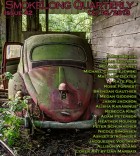What drew me first to this work was the distinctive word choice, the vivid sense of texture and animal and chemical stink you built up—and rhythm, though that’s a separate point. I was wondering if you could just talk about your choices here. Take this as broadly as you like.
Those keen sensory textures come from experience. Aesthetic choices had a lot to do with it, of course, but I would say that more than with most pieces I’ve written, this one pressed itself into textual existence out of the actual experience of attending the death of a family dog. That event seemed so clinical to me, so sad and so very clinical. I suppose I wanted to ritualize it, perhaps in compensation for the emotional sterility it left me with. I wanted to create a kind of ceremony through an ecstasy of perceptual—particularly olfactory—richness.
This was definitely a story that repelled me at first—the subject matter is not easy. I kept thinking, I can’t choose the dog-death story. But I kept opening the file and reading it. It is that richness. But it’s the way it is so contained too. Stamped. I’m very interested in the idea of ritual and how it mediates pain and horror, but does not distinguish it. I’m thinking of the ‘Anubis priest’ petter, and her eyes that are ‘unpretty, silver, wet machines, gunmetal and rain’. Do you think that the form of a flash fiction is perhaps more suited to the following of a ritualistic action, than, say, poetry or a short story?
I do think there’s something special about flash that lends itself to the kind of ritual I was going for there. I know any medium can convey just about anything, but flash has a special affordance in its brevity and in the way its compression permits a balancing of reportage and lyricism, of depicting something that is or that can be while invoking something that isn’t and can never be. I don’t want to devolve into obscurity about this but it’s a complicated thing to talk about. I was mentioning the other day (on my blog I think) the difference between a tradition of flash rooted in Chopin’s “Story of an Hour” and the tradition rooted in something like Ursula Le Guin’s “Horse Camp.” Chopin’s famous little nugget of compressed drama contains all the elements of traditional short structure, pressing the whole into one diamond of a story. There are many practitioners and readers of flash today who swear by this model. But then there’s a work like Le Guin’s “Horse Camp”—which is more like the flash I write. It tells a story that keeps you guessing, not just about what is happening but to whom or what it’s happening to. Are the main characters girls or horses, or are they hybrids, horses dreaming themselves girls? The language is evocative like poetry, but it’s not a poem. Not a prose poem. It takes liberties with meaning. Not with form necessarily, but with logic. I aim for similar territory in my flashes. I want to make things happen with words and sometimes my flashes are aggressive in their wordplay—in them word play is very serious business.
The possibilities of the hybrid and the intense, unpredictable routes available to flash interest me too. Can I ask a totally different question however—what are you trying to explore about the roles and experiences of the human and the non-human characters here? In their facilitating of a death, in the clinical spaces.
This is a great question, and I love the way you phrase it as a relation that comes about as a result of a facilitation of death. Death could be the shared experience between the human and the non-human. It could be the event that brings the two types of consciousness, the human and the non-human, together, bridging shared perceptual experiences of the past, braiding the past with the twin strands of memory (human) and olfactory perception (non-human). Aside from shared joys with this dog in particular, this flash held an unexpected interior space for me that conjured up other images of “exterminated” and “eliminated” animals—the image of mice being buried is traumatically real to me, something I witnessed at the age of four or five. The real fear about death in this flash is that all spaces will be clinical. The hope attached to that same fear is a sacrificial one: that this particular death will enable all of the clinical deaths of the non-human that have come before to grow angelic wings and finally fly away.
Where from here?
I have many irons in the creative fires. One is a series of flashes intended to inventory a range of non-human consciousnesses—of objects, places, and events. Another idea grows out of my interracial background as a mixed race person. I want to write flashes that stage a series of common misconceptions and arguments that happen between people around issues of race. I want to use the form of the flash and the flash chapbook to orchestrate conflicts in terms that are both emotionally honest and aesthetically original. These projects will unfold alongside my other major writing goal: to finish an academic study of graphic novels and the new forms of knowledge that comics and graphic novels make possible. That and keeping up with blogging should keep me plenty busy well into the next year.



 The SmokeLong Grand Micro Contest (The Mikey) is now an annual competition celebrating and compensating the best micro fiction and nonfiction online.
The SmokeLong Grand Micro Contest (The Mikey) is now an annual competition celebrating and compensating the best micro fiction and nonfiction online.